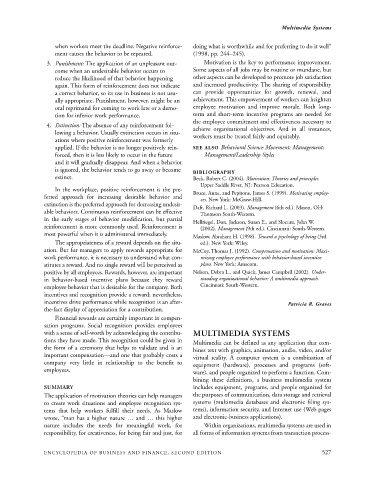Page 550 - Encyclopedia of Business and Finance
P. 550
eobf_M 7/5/06 3:15 PM Page 527
Multimedia Systems
when workers meet the deadline. Negative reinforce- doing what is worthwhile and for preferring to do it well”
ment causes the behavior to be repeated. (1998, pp. 244–245).
3. Punishment: The application of an unpleasant out- Motivation is the key to performance improvement.
come when an undesirable behavior occurs to Some aspects of all jobs may be routine or mundane, but
reduce the likelihood of that behavior happening other aspects can be developed to promote job satisfaction
again. This form of reinforcement does not indicate and increased productivity. The sharing of responsibility
a correct behavior, so its use in business is not usu- can provide opportunities for growth, renewal, and
ally appropriate. Punishment, however, might be an achievement. This empowerment of workers can heighten
oral reprimand for coming to work late or a demo- employee motivation and improve morale. Both long-
tion for inferior work performance. term and short-term incentive programs are needed for
the employee commitment and effectiveness necessary to
4. Extinction: The absence of any reinforcement fol- achieve organizational objectives. And in all instances,
lowing a behavior. Usually extinction occurs in situ-
workers must be treated fairly and equitably.
ations where positive reinforcement was formerly
applied. If the behavior is no longer positively rein- SEE ALSO Behavioral Science Movement; Management;
forced, then it is less likely to occur in the future Management/Leadership Styles
and it will gradually disappear. And when a behavior
is ignored, the behavior tends to go away or become
BIBLIOGRAPHY
extinct. Beck, Robert C. (2004). Motivation: Theories and principles.
Upper Saddle River, NJ: Pearson Education.
In the workplace, positive reinforcement is the pre-
Bruce, Anne, and Pepitone, James S. (1999). Motivating employ-
ferred approach for increasing desirable behavior and
ees. New York: McGraw-Hill.
extinction is the preferred approach for decreasing undesir-
Daft, Richard L. (2003). Management (6th ed.). Mason, OH:
able behaviors. Continuous reinforcement can be effective
Thomson South-Western.
in the early stages of behavior modification, but partial
Hellriegel, Don, Jackson, Susan E., and Slocum, John W.
reinforcement is more commonly used. Reinforcement is (2002). Management (9th ed.). Cincinnati: South-Western.
most powerful when it is administered immediately.
Maslow, Abraham H. (1998). Toward a psychology of being (3rd
The appropriateness of a reward depends on the situ- ed.). New York: Wiley.
ation. But for managers to apply rewards appropriate for McCoy, Thomas J. (1992). Compensation and motivation: Maxi-
work performance, it is necessary to understand what con- mizing employee performance with behavior-based incentive
stitutes a reward. And no single reward will be perceived as plans. New York: Amacom.
positive by all employees. Rewards, however, are important Nelson, Debra L., and Quick, James Campbell (2002). Under-
in behavior-based incentive plans because they reward standing organizational behavior: A multimedia approach.
employee behavior that is desirable for the company. Both Cincinnati: South-Western.
incentives and recognition provide a reward; nevertheless,
incentives drive performance while recognition is an after- Patricia R. Graves
the-fact display of appreciation for a contribution.
Financial rewards are certainly important in compen-
sation programs. Social recognition provides employees
with a sense of self-worth by acknowledging the contribu- MULTIMEDIA SYSTEMS
tions they have made. This recognition could be given in Multimedia can be defined as any application that com-
the form of a ceremony that helps to validate and is an bines text with graphics, animation, audio, video, and/or
important compensation—and one that probably costs a
virtual reality. A computer system is a combination of
company very little in relationship to the benefit to
equipment (hardware), processes and programs (soft-
employees. ware), and people organized to perform a function. Com-
bining these definitions, a business multimedia system
SUMMARY includes equipment, programs, and people organized for
The application of motivation theories can help managers the purposes of communication, data storage and retrieval
to create work situations and employee recognition sys- systems (multimedia databases and electronic filing sys-
tems that help workers fulfill their needs. As Maslow tems), information security, and Internet use (Web pages
wrote, “man has a higher nature … and … this higher and electronic-business applications).
nature includes the needs for meaningful work, for Within organizations, multimedia systems are used in
responsibility, for creativeness, for being fair and just, for all forms of information systems from transaction process-
ENCYCLOPEDIA OF BUSINESS AND FINANCE, SECOND EDITION 527

